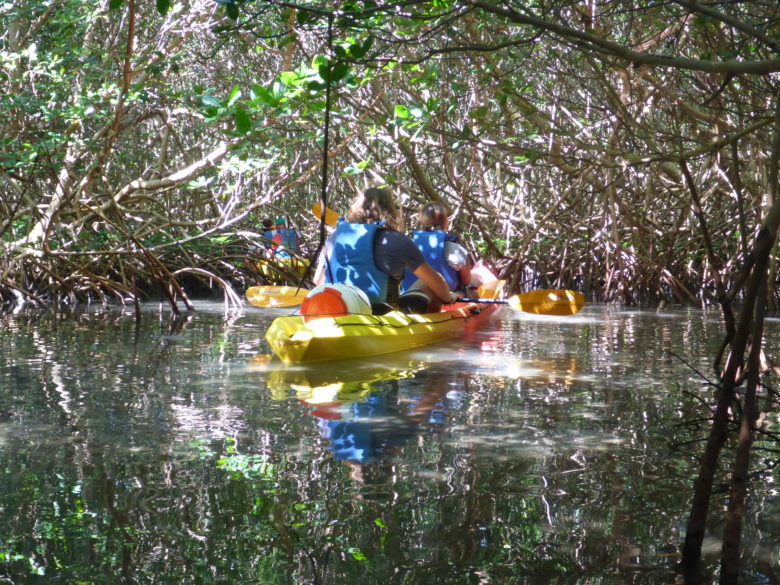16:09:68N 61:23:97W
On our first windless evening in the marina we slid the mainsail down its groove and onto the side deck, folded it like a fan then hauled it onto the pontoon and folded it up to fit in its bag. The voilier or sail-maker could not believe the poor quality of the thread used on an otherwise well cut sail made of top grade material.
The thread is brown in colour and his word for it translated perfectly from French to English being the slang for a common bodily function. The main could be described as thread bear just like a children’s teddy, over much of the surface the thread only existed as half stitches on one side of the sail. Other seams were ready to part. The voilier worked through the night and re-stitched the entire sail. Our original sail-maker in the UK, who made the sail for us in September 2014 was most apologetic when we sent him the photos and transferred the cost of repair into our account the next day.
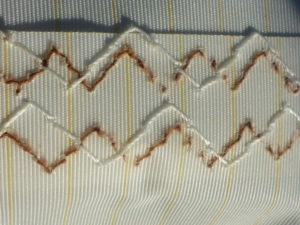
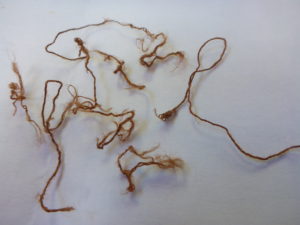
As we had already deduced it is the PCB (printed circuit board or brains) of the dessalator that is at fault on the watermaker so a new one and a new switch have been ordered from France under warranty and we have to wait a few days for it to arrive.
This marina is sheltered from water movement but not wind and rain. Sitting having a quiet Leffe beer in one of the bars at lunchtime, the heavens opened and Rob had to dash back to the boat to close windows and hatches. No one really minds getting wet though as it is nice and cool for a short while before the heat of the day dries you off.
The fridge compressor and plate have to be replaced. Although there is still some gas left in it the gas is no longer obtainable as it was destroying the ozone layer so the parts are obsolete. Modern design has made the compressor less power hungry but the gas is only expected to last 10 years, instead of over 25 like our last one.
The cost of replacement and fitting would be £1,000. Sitting in the cockpit we were working out how to meet this latest bill when I remembered I had some funds in my Pay Pal account after selling numerous items on Ebay, that calm anchorage of liquidable assets. 24 hours later the funds were ready in our joint account to pay for the new fridge, which should use only 3 amps instead of 5 or 6 amps.
We had to celebrate one free repair, one warranty repair and one Pay Pal purchase so we hauled ourselves up onto high stools in a little, all French wine bar for a glass of Muscadet for me and a glass of Merlot for Rob and a platter of French cheeses from the low to the mountain regions of the mother country.
The final few days of our crossing provided ample rainwater to wash Zoonie from rigging to deck, but with the bimini up the cockpit escaped the rain so I used warm water and a tiny drop of ‘delicates’ detergent and with a soft brush gently cleaned the teak planks on the cockpit sole and seats. Well it came off dark brown and after a freshwater rinse and some sun the wood dried lighter than I have seen it for a while. Next is the bright-work, the stainless steel.
We have noticed, on our busy visitors’ pontoon, that most other yachts are Swiss, Swedish, French, USA, Canada, South Africa and Australian. There are no German yachts at present, or Irish, Spanish or Portuguese and only one or two other UK yachts at the moment. Having said that Tim and Philippa have just come in alongside in their Westerly 38 from Southampton, towed in from their anchorage at great expense by a customs boat as the engine would not start. As two customs officials escorted Philippa to the nearest ATM she recalls, “People must have thought I was either very important or very naughty!”
So next we hired a car for three days to explore the two islands that make up Guadeloupe, the Papillon or Butterfly Island.
Guadeloupe by car.
The only evidence of ‘Death in Paradise’ we could find in Deshaie was in the form of six well fried fish skewered together on a pyre of salad leaves in a tiny restaurant. It seems this pretty seaside town on the NW corner of the island is the base used by the production team and actors of the popular UK TV series. Much of the filming is also done on a little island we can see from our restaurant table called Kahouane and in various locations around and about.
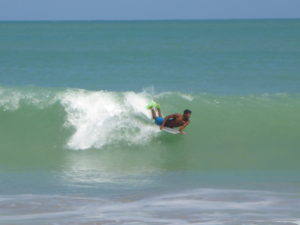
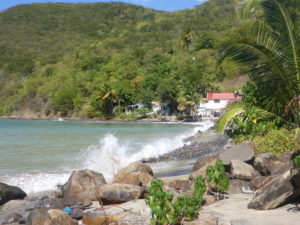
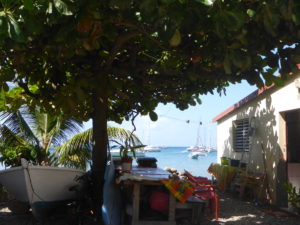
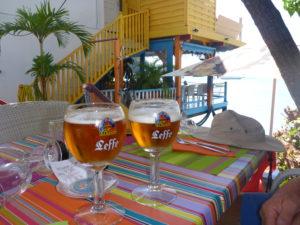
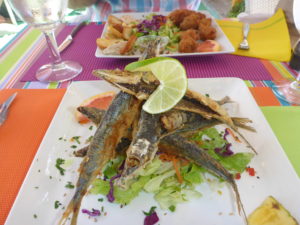
We stirred the koi carp into a feeding frenzy at the Botanic Gardens and walked amongst some giant parrots staring at us with beady eyes from their high perches. There were plenty of luxuriant flowers, hibiscus, orchids etc. and lofty old trees, big enough to be enfolded by their flying buttress roots and the waterfalls and rushing streams were refreshing to the ear but by far the best part of the day was spent getting very muddy on a forest walk.
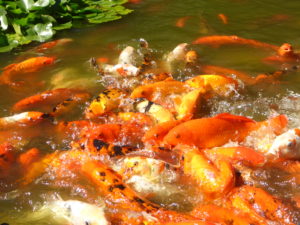
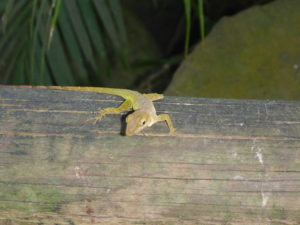
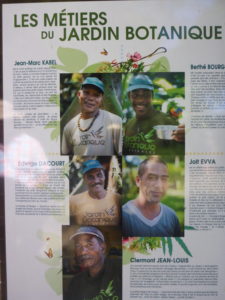
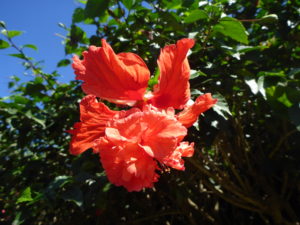
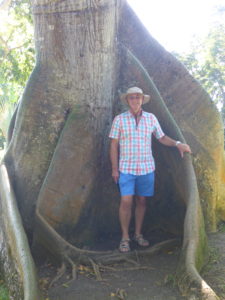
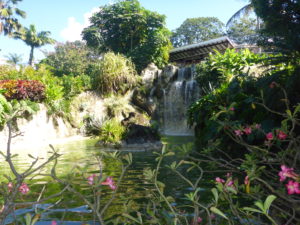
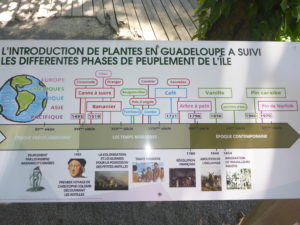
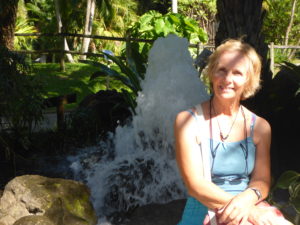
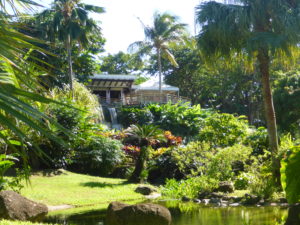
Parked beside the scenic route that traverses Basse Terre, the western island, in sandals and flip flops, we followed a little long tailed mid brown creature, a little like a mongoose, onto the trail and in fading light set off. Little invisible frogs croaked and distant birds created our musical accompaniment. The natural knotting of roots made up our path and provided soggy but secure footfalls in between them for the ups and downs. Everything dripped giant refreshing drops of cool water and we marvelled at the enormity of leaf growth in these hot and wet conditions. I picked up a giant leaf and Rob said, “We could use that as an umbrella!”
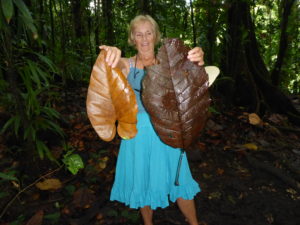
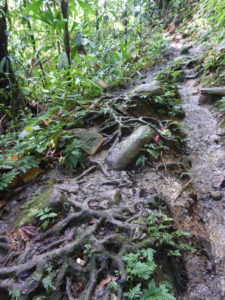
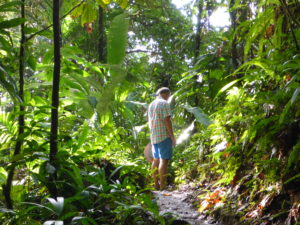
We cleaned our shoes in the rushing river before crossing over it on the wooden suspension bridge and back on the well-manicured and deep ditched forest road heading for home.
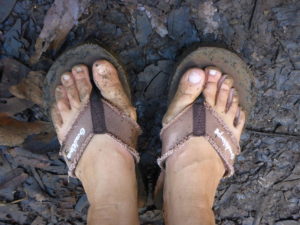
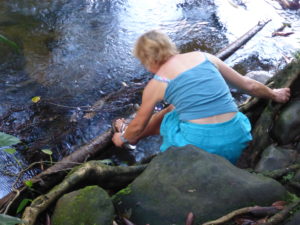
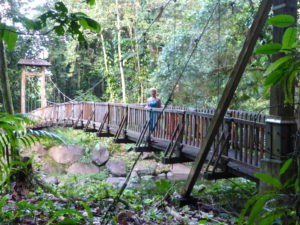
The next morning did not start well. We were due to be donning buoyancy aids ready for our kayaking trip at 9.00am so we left the marina an hour earlier for what appeared on the map to be a straight-forward drive, past the airport to Vieux Bourg. But hey there’s a new roundabout here so we turned too early, and where are the road markings that would have stopped us continuing straight on where the main road veered left?
We doubled back at least twice and by 8.38am were convinced we wouldn’t make it in time for paddle off. I held Rob’s dead mobile phone in my hand, when we needed it most it had discharged all its battery life like a dying bird.
“Just keep the sun behind us babe,” I said as a last resort, when our drive disgorged us suddenly into the very shore-side car park we needed with an array of small motor boats tied to two dilapidated pontoons and a big sailing catamaran at the end. Quite how we made it to our desired location and parked up at precisely 9.01am we will never know.
The ethos at Ti Evasion Kayaks is to make their trips affordable for families and at 35 Euros each for 4 hours of salty fascination well that is a very good start. David was our guide, he is working here after a spell as a kayak and walking instructor in the Pyrenees and will eventually move on to Greenland he says.
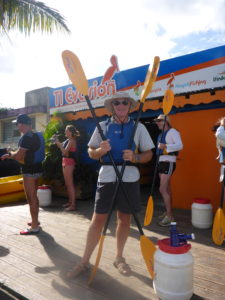
He led 14 of us in 10 kayaks into the red mangroves beneath circling Magnificent Frigate birds and an Osprey and every now and then would gather us together in a floating raft to tell us what he knew. Did you know that like us mangroves have dessalators, tiny white dots on their aerial roots that filter out excess salt? Also, like with us, sometimes their system does not work too well so they have an override system whereby excess salt is passed into their dying leaves and shed when the yellow leaves fall into the water. Isn’t nature brilliant?
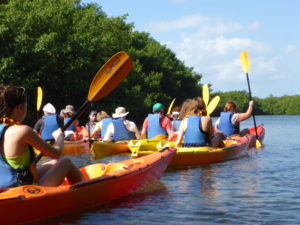
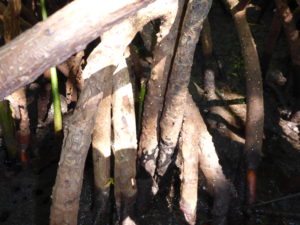
The plentiful medusas, or jellyfish that live around here are harmless and live upside-down. This is so that the nearby seaweed can send food directly to them so they can stay around and don’t have to spend their lives floating through the sea.
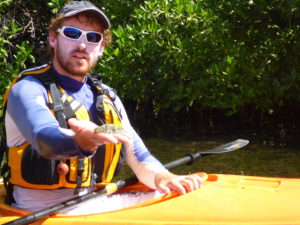
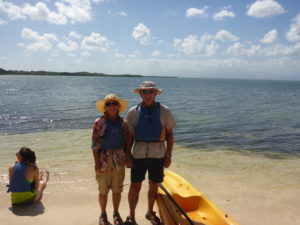
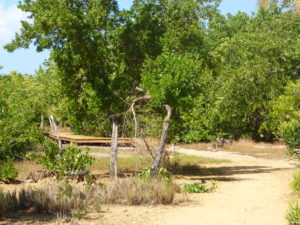
In 1989 hurricane Hugo destroyed all but one of the mangrove trees and we beached just below that ‘one’ which is now surrounded by new growth. Mangroves re-produce with long pen like baby plants that fall and plant themselves with their knib-like tips, straight into the thick, methane oozing, oxygen less mud. But we planted ours into the sand amidst a little forest of previously planted baby mangrove shoots. Like ducklings behind their mother on their first trip out, we paddled keenly in single file behind David back to the centre where he rounded our perfect morning off with a beaker of fruit punch.
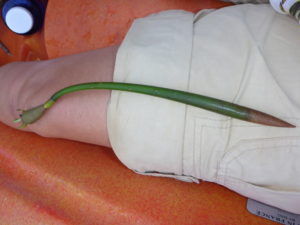
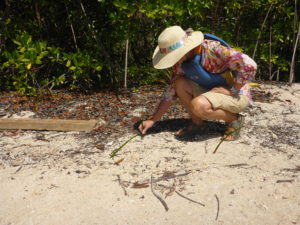
During our earlier perambulations before the kayak trip Rob had seen a sign to a little beach called Playa Babin, so we re-found it for lunch. And what a find. It looked over ‘our’ mangrove lagoon and the single tall mangrove tree. Protected by a reef the water was warm and shallow and wave less. After a light lunch we swam next to a father who was plastering his giggling son with mud.
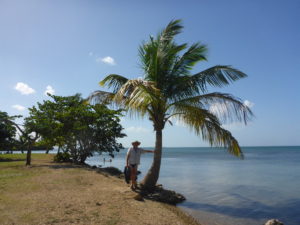
There was a nice tree shaded area with picnic tables and few people there; it reminded me of a beach on the shore of the Solent near Lepe where I used to take Emily and friends for isolated peaceful picnics during her growing years. We had to pay £19 for an annual permit and would be looked at disapprovingly by snooty cottage dwellers as we drove past their homes. When there was enough wind we would fly a kite from a stone for the duration of our stay. We called it ‘The Secret Beach’.
At The World of Canne, a sugar plantation back on the butterfly island, we followed our own route with our speaking pods to our ears. The audio commentary was good as were the ideas behind setting up this historical reminder of the harsh lives of the slaves but like the old plantation itself it was all falling into neglect and numerous buildings were closed including the restaurant. The cute little train no longer took visitors along the 50km network of railway that once made the canne extraction more efficient than using beasts and carts. I hoped it would keep going just for school groups if no-one else.
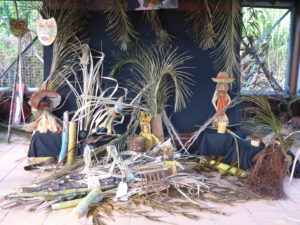
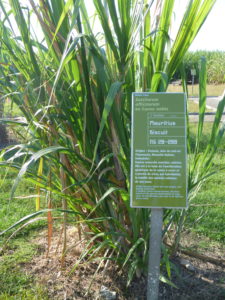
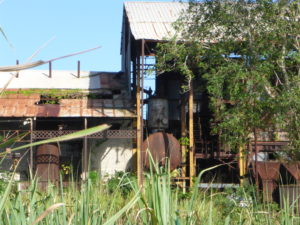

In November 1493 Christopher Columbus landed on Basse Terre, near a little place called ‘Saint Marie’, perhaps that’s what he said when he stepped ashore in search of drinkable water. Friendly locals directed him to some nearby falls, Les Chutes de Carbet and we visited them too. Along a well paved path this time, amidst frequent rain showers we walked the 30 minutes to the second of three falls, shedding the mass of tourists by doing so and had to talk with raised voices above the watery din. ‘Our falls’ were even bigger and more swollen than the picture on the brochure, this being the end of the rainy season. I know that a forest has to be rained on every day of the year to be termed a ‘rainforest’ so this is a ‘rainy forest’ in my mind.
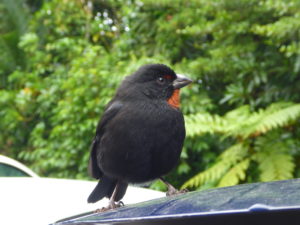
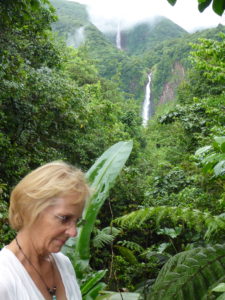
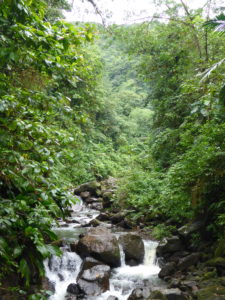
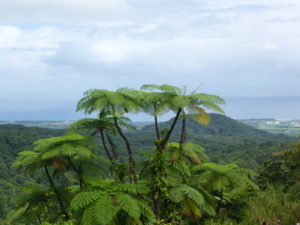
Continuing briefly along the ‘La Route de l’Eslave’ the route of slaves, established in memory of the slaves of Guadeloupe, we drove a seat clenching drive up the Grand Riviere valley to the Griveliere Coffee Plantation which through its 250 year history has also grown cocoa, bananas and vanilla. The tour guide spoke only French so we took ourselves off and Rob found coffee beans on a plant and then cocoa pods. I spotted the ruins of the old slave huts near the reconstructed versions and we enjoyed a delicious drink of Arabica coffee produced on this plantation way up in the hills. Today’s black workforce are paid and appear to enjoy their work but their ancestors had a totally different life. Back on Zoonie we watched ‘12 Years a Slave’. Not that we are likely to forget their suffering.
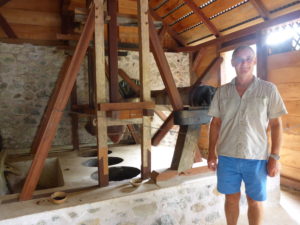
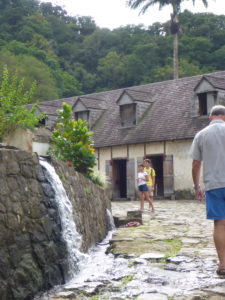
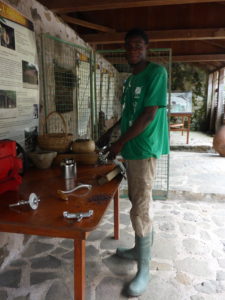
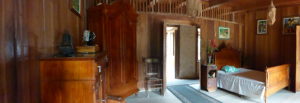
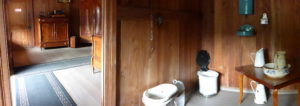
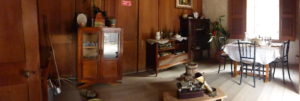
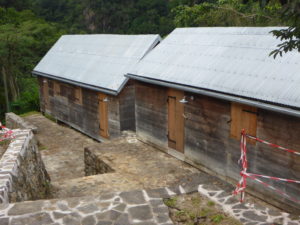
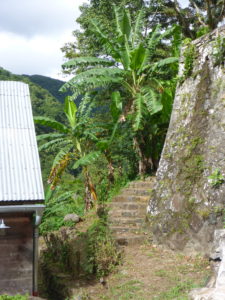
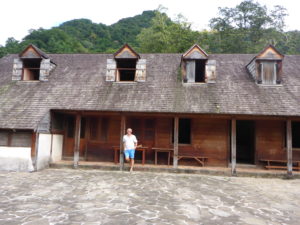
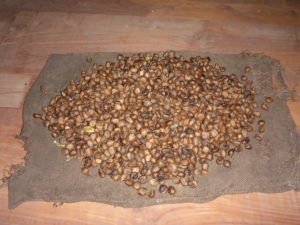
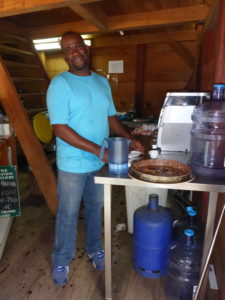
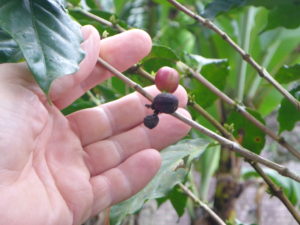
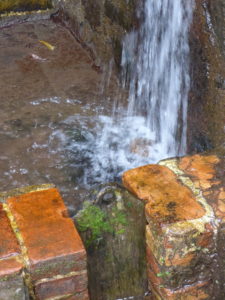
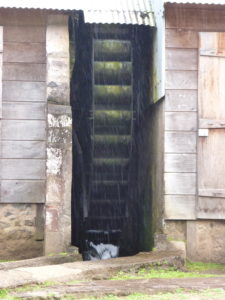
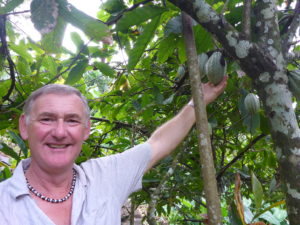
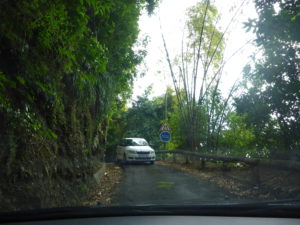
Finally, the Playa de Malendure opposite Islets Goyaves and de Pigeon on the sheltered west coast is a perfect location for anchoring, snorkelling and diving and just swimming and lazing about on grey volcanic sand. So we sipped a small beer for an hour and soaked it all in if only visually, thinking we would come back for a day maybe with snorkels etc.
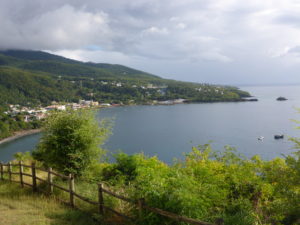
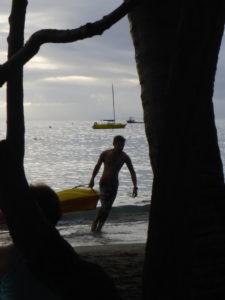
Guadeloupe – last few days.
Our week long wait for the new board for the watermaker has been relieved by a day in Pointe a Pitre and the company alongside of Tim and Philippa from England aboard their Moody 38, Seraphim.
Last evening we were invited aboard for drinks along with Simon who is crewing for Judy aboard her Catalina 42, based in Malta. The previous evening Philippa and Tim drank on board with us and we must have been so in need of a good chin wag in our native tongue that both evenings stretched into their nights and Rob has had to retrieve his head from the shed twice. Still it was well worth it.
Lots of little jobs have been done on board; Zoonie’s bright work now shines so bright having had its layer of salt cleaned off that sunglasses are obligatory from the cockpit outwards. I was busy polishing the stanchions (vertical supports for the guard rails) when I heard a massive splash as one of the local pelicans dived for a fish.
Charming French Richard, our fridge compressor man, sped along the pontoon on his motorised skateboard, which was wide enough to also carry his toolboxes and new parts, and heads together we peered into the fridge to see where would be best to mount the new plate. That agreed we were soon enjoying our new cooling unit.
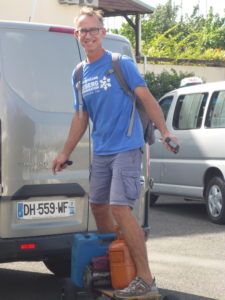
Electrician Fred could no longer stand the head of the Caribbean and fitting our new watermaker motherboard was one of his last jobs before returning to Ottawa.
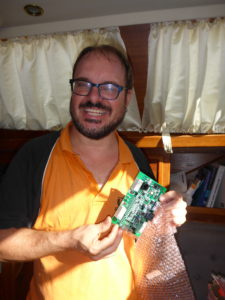
We caught a bus into the ‘city’ and went firstly to the very new Memorial ACTe Slave Museum which was opened last July by French President Hollande. You know how it is when, through your adult life, you learn snippets of knowledge and information about a subject, in this case The Slave Trade.
Well I have never before been in a museum that so effectively and efficiently tells the entire story of this dark trade from Arabic Muslim start to the present day and recognises that the old trade may have been abolished but slavery never will be.
We passed from room to room with our English commentary recording overlaid over animated film of people telling the story. There was a room made out like a lecture hall complete with brass desk lamps and a courtroom where an abolitionist was on trial. A giant ‘peace’ tree covered in symbols from Africa brought over by the slaves was re-assembled after its tour of the world.
We wandered along a re-created Carnival street filled with fabulous costumes to celebrate creole festivals and along a narrow dark corridor literally walking over the lying, writhing life size images of the slaves as they would have been crammed sardine-like aboard their death ship.
Simple numbers can be so evocative, 12.5 million slaves left the African west coast and 10.5 million landed in the West Indies. After three hours at this rich memorial to slavery we walked in to the Tourist Info centre in town and were recommended the Marie Galante Restaurant for lunch.
We were famished. The first genuine Guadeloupe meal we had tasted comprised a choice of pork, chicken, lamb or red fish with steamed white cabbage, grated carrot and white rice, the latter did not contain peas because we arrived too late (!). The red beer was good, 5.9% and spiked with Tequila! The meal, at least the fish version, was very like common Zoonie fare.
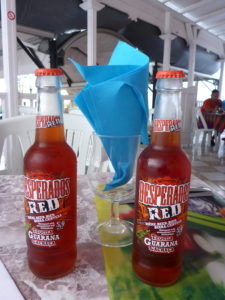
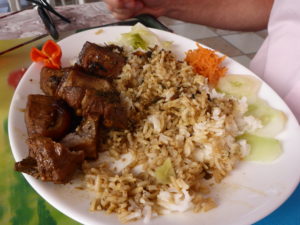
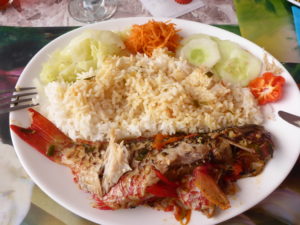
After lunch, or possibly the beer, our energy levels were flagging but we managed to discover a genuine example of a cottage industry. The gingham material that we see used so much here, not only in clothes but table coverings and household goods, was cut and sewn into beautiful dresses for all sizes and ages right behind the counter of the shop. I couldn’t resist a top in my favourite colours.
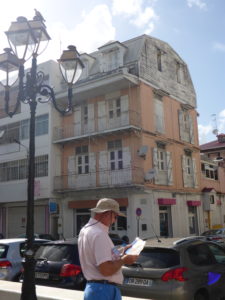
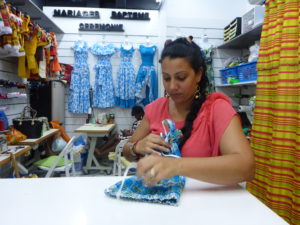
In the covered market stallholders sold bottles decorated with gold and silver and filled with varieties of flavoured rum and spices and were just starting to pack up. A cruise liner sounded her siren to get all her punters back on board ready to slide off to the next port.
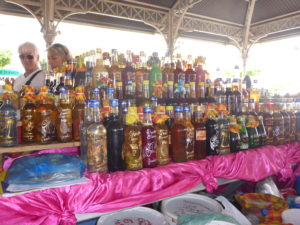
The town is very compact and it looks as if people have moved from their old wooden shacks, a few of which remain, into new small apartment blocks, so there is evidence of the old town alongside the new.
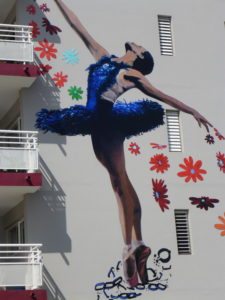
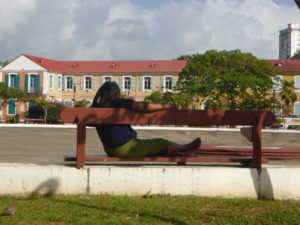
At the bus stop a young drunk man was trying to extract the correct bus number for the marina from two bewildered local girls, so we told him the number. He then told us how he disliked the city and was heading for Antigua, which he thought would be much nicer. I wondered if he formed his opinion before or after his inebriation. Stall holders packing up their van ignored a tall, black man, wearing only the briefest trunks as he flashed at them, must be the heat!
Yesterday we had a lovely chat with both grand-children, Henry and Ruby, just after they returned from school. Beavers is a big hit with Henry and Ruby was preparing for a teddy bears’ picnic.
We have been doing our homework over the Panama Transit and I have emailed the Ships Agency. As we are not fluent in Spanish it is best to have an agent or we could be ripped off somewhere along the process. Shelter Bay Marina is where we will stay while arrangement are made, so I have also contacted them.
At 8.30 this morning, with no fuss or assistance, Tim and Philippa left with their engine now starting and stopping when asked. Soon it will be our turn.
